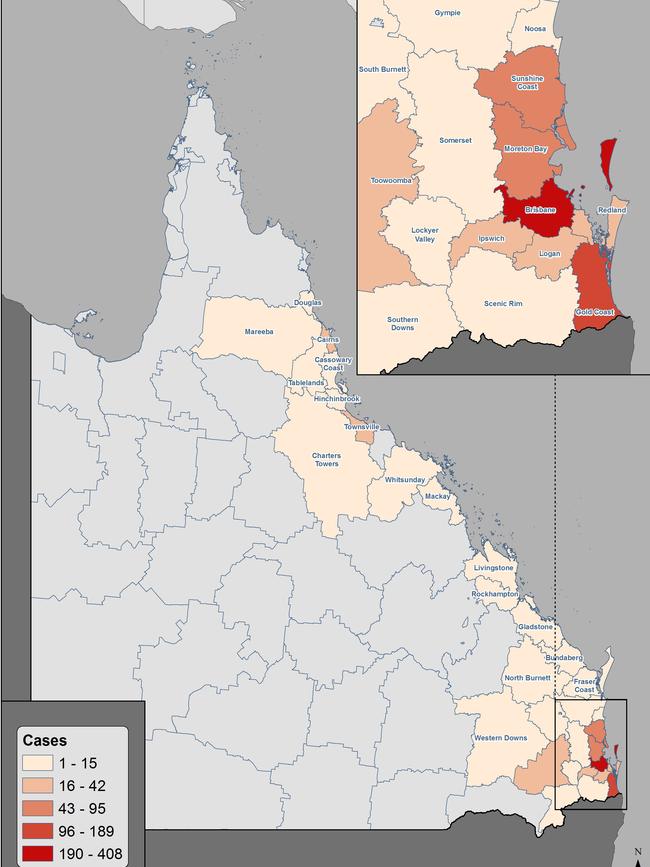Heat maps reveal Qld regions hardest hit by coronavirus
New data released by the State Government reveals the region’s hardest hit by coronavirus and the Queenslanders most at risk of contracting the disease.
QLD News
Don't miss out on the headlines from QLD News. Followed categories will be added to My News.
ABOUT three-quarters of Queensland has not recorded a single case of coronavirus and only 15 people over 80 have been infected, heat maps released yesterday reveal.
Most of the state’s cases of the virus, which has killed six elderly Queenslanders, are concentrated in heavily populated Brisbane and the Gold Coast, which both have international airports.
New data reveals number of COVID-19 cases in each local government area
‘Really good numbers’ not enough to reopen schools amid pandemic

The maps reveal 785 of the state’s 1024 cases acquired the novel virus overseas, representing more than 76 per cent of known infections.
Another 170 people contracted it from other confirmed cases, in 42 people the source cannot be traced, 17 people were infected interstate and investigations are ongoing in 10 cases.
In the 85 days since Queensland’s first case of COVID-19 was diagnosed on the Gold Coast, vast tracts of land on Cape York and in western and central Queensland have remained free of the pandemic infection.
But Lisa Davies-Jones, CEO of Queensland Health’s Office of Rural and Remote Health Establishment, urged all communities to continue their vigilance.
She said detailed plans were in place for the possibility of coronavirus outbreaks in the bush, including the expansion of emergency department and intensive care capacities, increasing telehealth services and boosting aeromedical retrieval services.
The new data reveals about one per cent of the state has been subject to a quarantine order during the crisis with 55,533 self-quarantine notices issued.
Of those, 2971 are still active, including 249 in the Cairns and Hinterland Hospital and Health Service district, where a cluster of cases has been linked to a Pathology Queensland laboratory.
Despite continuing signs Queensland is putting the brakes on the spread of the novel coronavirus, Chief Health Officer Jeannette Young said people should continue to stay in their own communities.
“I don’t want to see people in one community going a long distance to another community because we know … there are some parts of the state there’s a lot more cases than other parts so it’s really important that we don’t move the virus from one part of the state to another,” she said.

“The restrictions that are in place at the moment are onerous. I don’t underestimate what it means for individuals, for families and communities to follow these restrictions, but we know they’ve got to remain in place.”
National Cabinet is expected to make a decision on the easing of some restrictions next month.
Although every death of Queenslanders with COVID-19 has been in those aged in their 60s and older, people in their 20s are the most at risk age group in terms of contracting the virus, perhaps reflecting the people most likely to travel.
Twenty-somethings make up 23 per cent of all identified infections in Queensland with 236 cases, followed by people in their 60s, who account for 166 infections. Fourteen cases have been recorded in Queensland children aged 10 and under, suggesting they aren’t “super spreaders” of the virus as they are with flu. Queenslanders in their 80s, the group most likely to be in aged care facilities, account for just 15 cases. Unlike NSW, the state is yet to have an outbreak of the virus in a nursing home.

The release of the data coincided with a joint plea from Dr Young and Premier Annastacia Palaszczuk to locked-down aged care facilities to allow residents out of their rooms and to end blanket bans on relatives visiting.
Dr Young last week upgraded a public health directive relating to nursing homes requiring visitors and staff to have an up-to-date flu vaccination before being able to enter from May 1. Her directive also bans visits by children aged under 16 years unless the resident is at the end of life and restricts residents to one visit a day for the purposes of “care and support”.
But Dr Young said she was concerned about nursing homes going beyond her directive and locking down homes completely, banning even relatives from visiting and some going so far as confining all residents to their rooms.
“It doesn’t make sense,” she said.
“We know that the outbreaks that have occurred in Australia in nursing homes, in the main, have actually been due to staff or due to residents. We haven’t seen outbreaks where someone has been visiting.
“I really hope they take on board the advice and look at what they’re doing so they can look after not only the physical aspects of their residents’ care but the mental aspects.”
Originally published as Heat maps reveal Qld regions hardest hit by coronavirus


